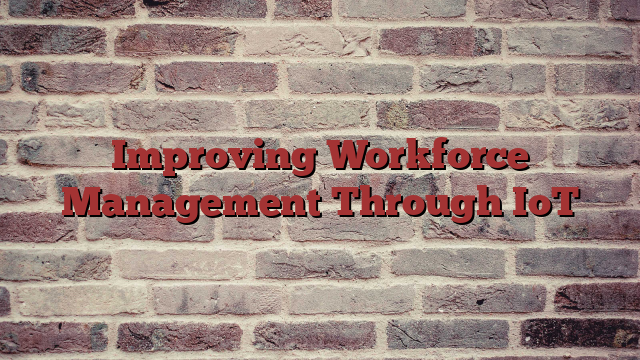In today’s dynamic business landscape, managing a dispersed workforce efficiently is paramount. Workforce management software has emerged as a game-changer, offering streamlined solutions to tackle the challenges inherent in overseeing a geographically diverse team.
Workforce management software is a comprehensive platform designed to optimize and streamline various facets of managing a workforce. It encompasses scheduling, task allocation, time tracking, and performance monitoring, all under one digital umbrella.
Efficient workforce management software ensures that the right people are in the right place at the right time, facilitating smooth operations and boosting productivity. This is particularly crucial for industries with field employees, where effective coordination and real-time insights are essential.
Understanding IoT in Workforce Management
- Exploring IoT’s Role in the Workplace
The Internet of Things (IoT) has transcended its initial role in the consumer sphere, making significant inroads into the realm of mobile workforce management. IoT involves connecting devices and systems to the internet, enabling them to communicate, collect, and exchange data.
- Integration of IoT with Workforce Management Software
In the workplace, IoT integration with workforce management software involves leveraging interconnected devices and sensors to gather real-time data. This data is then seamlessly integrated into the software, providing actionable insights for efficient workforce operations.
Benefits of IoT Integration in Workforce Management
Enhanced Real-Time Tracking and Monitoring
Integrating IoT into workforce management systems enables real-time tracking and monitoring of employees, assets, and operations. IoT devices, such as wearables or GPS trackers, provide accurate location data, allowing managers to oversee field teams’ movements and activities instantaneously.
Improved Data-Driven Decision-Making
IoT-generated data offers valuable insights that enhance decision-making processes. Analyzing this data allows for a deeper understanding of employee behavior, productivity patterns, and resource utilization. Managers can use these insights to optimize workflows, allocate resources efficiently, and identify areas for improvement.
Increased Operational Efficiency
IoT integration streamlines workflows by automating various tasks and processes. Devices interconnected through IoT communicate seamlessly, reducing manual interventions and administrative burdens. This efficiency boost allows employees to focus on more critical tasks, thereby enhancing overall productivity.
Enhanced Safety and Security Measures
IoT-enabled devices contribute to a safer work environment. Sensors and smart devices can monitor environmental conditions, equipment performance, and employee safety. This real-time monitoring capability helps in detecting anomalies promptly, preventing accidents, and ensuring compliance with safety protocols.
Flexibility and Adaptability
IoT integration fosters flexibility in adapting to changing business needs. The scalability of IoT systems allows organizations to adjust their workforce strategies according to evolving demands, technological advancements, or market shifts, ensuring they remain competitive and relevant.
IoT Applications in Employee Management System
- Tracking Employee Productivity and Performance
IoT devices, such as wearables or smart sensors, enable the monitoring of employee activities and performance metrics. This allows for objective assessments, identifying top performers and areas requiring improvement.
- Optimizing Resource Allocation and Scheduling
Through IoT data, organizations can optimize resource allocation and scheduling. Real-time insights into workflow patterns and employee availability facilitate better scheduling, ensuring that resources are utilized optimally.
Challenges and Solutions in Implementing IoT in Workforce Management
Common Hurdles Faced During IoT Integration
Connectivity Issues and Infrastructure Compatibility
Integrating IoT devices with existing infrastructure can pose connectivity challenges. Legacy systems might not seamlessly sync with modern IoT technology, requiring upgrades or adapters for compatibility.
Data Security and Privacy Concerns
IoT devices collect vast amounts of sensitive data. Ensuring the security and privacy of this data, especially during transmission and storage, is a critical challenge. Vulnerabilities in IoT networks could expose data to potential breaches and cyber threats.
Resistance to Technological Change
Resistance to adopting new technology remains a significant hurdle. Employees might be apprehensive about using IoT devices due to unfamiliarity or concerns about job displacement. Overcoming this resistance necessitates comprehensive training and change management strategies.
Read More – Service Management Software
Strategies to Overcome Integration Challenges
Robust Data Security Measures
Implementing robust encryption protocols and secure authentication methods is paramount. Regular software updates, firewalls, and intrusion detection systems fortify IoT networks against potential cyber threats, safeguarding sensitive data.
Employee Training and Education
Comprehensive training programs are essential to familiarize employees with IoT devices and their benefits. Educating them on data security measures, operational procedures, and the advantages of IoT adoption fosters acceptance and engagement.
Collaborative Approach and Stakeholder Involvement
Engaging stakeholders and involving key decision-makers throughout the integration process is crucial. Collaborative efforts ensure that organizational goals align with IoT initiatives and facilitate smoother adoption across departments.
Continuous Monitoring and Evaluation
Ongoing monitoring and evaluation of IoT systems are essential. Regular audits, performance assessments, and addressing potential system weaknesses through updates or improvements are vital for long-term success.
Security and Privacy Concerns in IoT-Enabled Workforce Management
- Addressing Security Risks Associated with IoT Devices
IoT devices, while beneficial, introduce security vulnerabilities. Hackers might exploit these devices to access sensitive data. Implementing encryption, secure authentication methods, and regular software updates are vital in mitigating these risks.
- Ensuring Data Privacy in IoT-Driven Systems
Data privacy is paramount in IoT-enabled systems. Strict adherence to compliance standards, such as GDPR or HIPAA, ensures that personal and sensitive information remains secure. Permission-based access and secure data transmission protocols safeguard against breaches.
Case Studies Illustrating Successful IoT Integration
- Real-World Examples of IoT’s Impact
Several organizations across industries have successfully integrated IoT into their workforce management strategies. Companies leveraging IoT-enabled devices for tracking, monitoring, and optimizing field operations have witnessed significant improvements in efficiency and productivity.
- The Benefits Witnessed by Adopters
These case studies highlight improved employee accountability, streamlined workflows, and enhanced decision-making. The ability to monitor resources in real-time and adapt operations based on IoT-generated insights has been instrumental in their success.
Read More – The technology shaping the future of mobile worker safety
Future Trends and Innovations in IoT-Enabled Management
- Emerging Trends Shaping the Future
The future of workforce management through IoT promises continued evolution. Trends like AI-driven predictive analytics, edge computing for faster data processing, and further integration of IoT devices will reshape how organizations manage their workforce.
- Predictions for IoT’s Evolution
As technology advances, IoT’s role in workforce management will expand. Predictive maintenance, AI-powered employee performance analysis, and seamless connectivity through 5G networks are some anticipated advancements in this domain.



